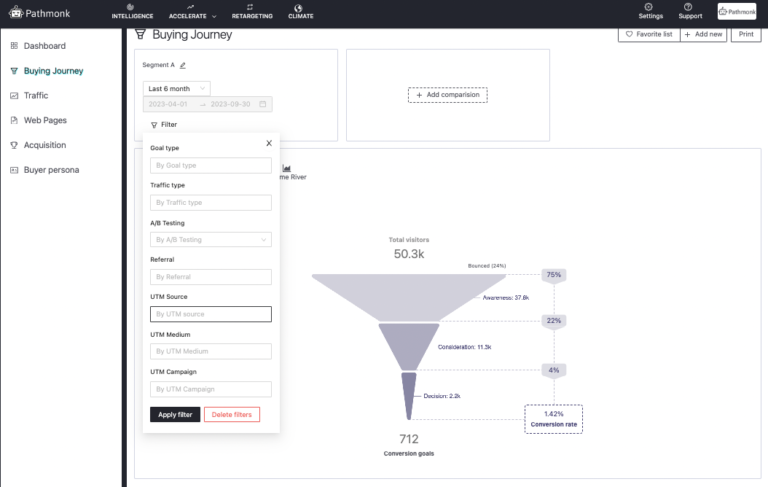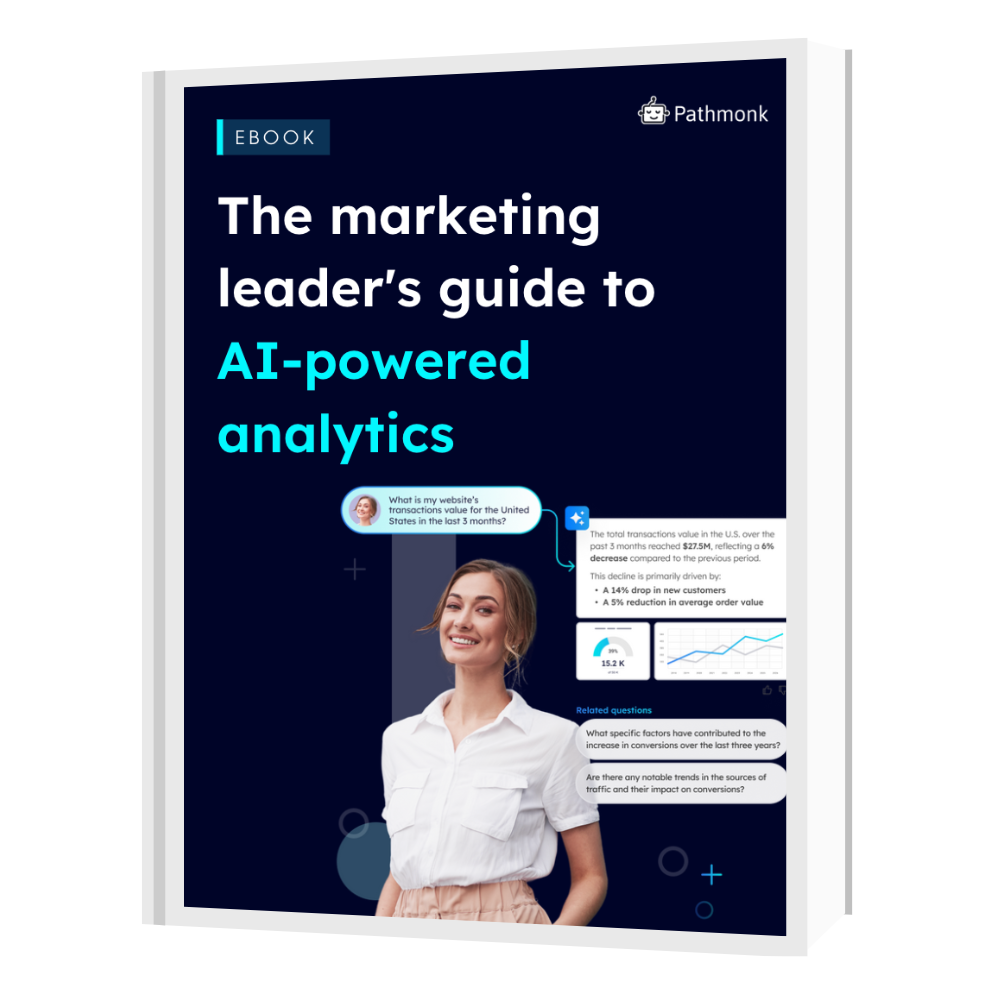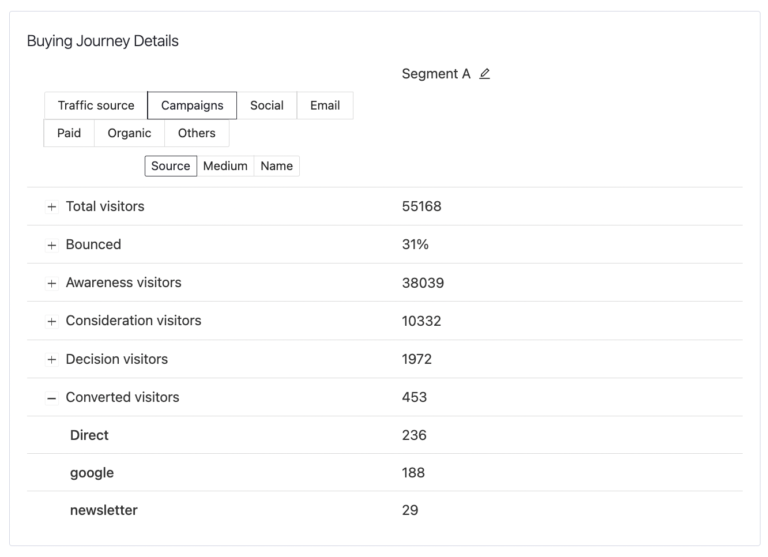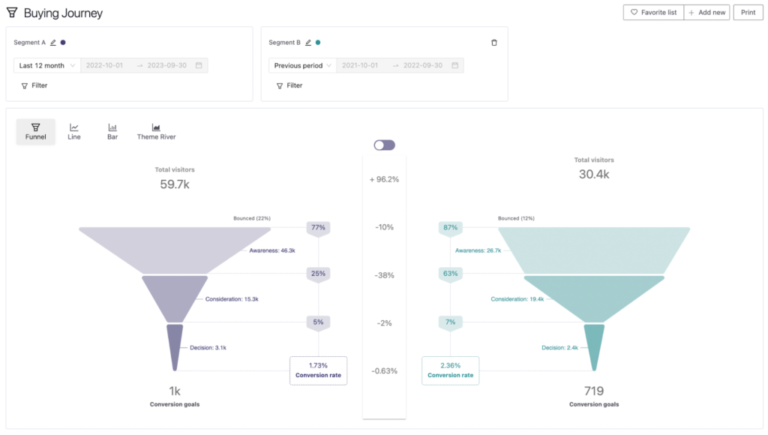
Businesses that leverage data-driven marketing are 6 times more likely to achieve profitability year-over-year compared to those that don’t.
Yet, with the vast array of tools and metrics available, many organizations struggle to turn raw data into actionable insights. Complicated dashboards, scattered information and useless noise can turn a marketer’s life into a living hell.
Thankfully, there is a way to make smarter decisions, create more effective strategies, and successfully measure the impact of your campaigns on conversions.
Here we’ll explore the different types of marketing analytics, their practical applications, and the best practices to take your marketing analytics to the next level.
Table of Contents
The 5 Types of Marketing Analytics
Marketing analytics isn’t a one-size-fits-all tool. To truly maximize its impact, it’s essential to grasp the different types and their unique purposes. Let’s break down the key categories, and while we’re at it, introduce the often-overlooked distinction between tactical and strategic analytics.
1. Descriptive analytics: what happened?
This is the starting point for any data-driven marketer. Descriptive analytics focuses on analyzing historical data to answer questions like:
- How many leads did we generate last quarter?
- Which campaigns performed best?
Key tools and techniques: Reports, dashboards, and basic metrics like click-through rates (CTR) and return on investment (ROI).

Practical case: Imagine running a series of email campaigns. Descriptive analytics helps you measure open rates, clicks, and overall performance to see which approach resonated most with your audience.
2. Diagnostic analytics: why did it happen?
When something unexpected happens—like a sudden dip in website traffic—diagnostic analytics steps in to uncover the reasons behind it. This involves digging deeper into the data to identify patterns, anomalies, or correlations.
With this analytics you will answer questions like:
- Why did a campaign underperform?
- What factors drove the success of a product launch?
Practical case: If your website traffic plummets, diagnostic analytics might reveal that a change in Google’s algorithm or increased competition in your target keywords was the cause.
3. Predictive analytics: what will happen?
Using historical data and advanced techniques like machine learning, predictive analytics forecasts future trends. It’s like having a crystal ball—one backed by data science.
It can be good for things like:
- Predicting customer churn.
- Forecasting sales during a promotional period.
Practical case: A SaaS company can use predictive analytics to determine which free-trial users are most likely to convert into paying customers, allowing for targeted interventions.
Translate all your data into clear insights
Discover how to future-proof your marketing data strategy with AI-powered analytics.

4. Prescriptive analytics: what should we do?
Prescriptive analytics doesn’t just stop at predicting outcomes; it goes further by recommending actions to achieve desired goals. This is where AI-driven tools shine.
It’s the ideal analytics for:
- Suggesting optimal pricing strategies.
- Offering recommendations for cross-selling or upselling.
Practical case: An e-commerce brand can use prescriptive analytics to dynamically adjust pricing during peak shopping seasons, ensuring competitiveness while maximizing profits.
5. Real-time analytics: what’s happening now?
For businesses that need instant insights, real-time analytics provides a snapshot of current performance. This is especially critical in fast-paced industries or for time-sensitive campaigns.
You should use it for:
- Monitoring live campaign performance.
- Tracking real-time social media mentions.
Practical case: A brand launching a new product can monitor social media engagement in real-time to gauge customer sentiment and adjust messaging on the fly.
Tactical vs. strategic analytics: the bigger picture
Now that we’ve laid out the different types of marketing analytics, it’s important to consider how they fit into your broader goals. This is where the distinction between tactical and strategic analytics becomes essential:
Tactical analytics for short-term wins
Tactical analytics is all about optimizing specific campaigns, channels, or initiatives. It’s data-driven decision-making at a micro level, helping you tweak, test, and improve your immediate results. Examples include:
- Analyzing ad performance to improve click-through rates.
- Measuring email engagement to refine subject lines.
Strategic analytics for long-term vision
Strategic analytics, on the other hand, takes a bird’s-eye view. It’s about aligning data insights with your overall business objectives. Examples include:
- Evaluating the lifetime value of customers across different segments.
- Identifying market trends to inform future product launches.
They’re both highly relevant, as tactical analytics are the day-to-day fuel that keeps your marketing engine running efficiently, while strategic analytics ensures you’re steering the car in the right direction. The two complement each other, creating a balance between immediate performance and long-term growth.
Why You Should Be Using Marketing Analytics
Marketing analytics empowers you to craft campaigns, refine strategies, and make data-driven decisions. Here’s why embracing marketing analytics is essential for your strategy:
1. Optimize campaign performance
With marketing analytics, you can fine-tune campaigns for maximum impact. By analyzing metrics like click-through rates (CTR), conversion rates, and customer engagement, you’ll know exactly what works—and what doesn’t.
Imagine running a multi-channel campaign. Analytics helps you identify which channels yield the best ROI so you can allocate resources more effectively.
2. Enhance customer understanding
Marketing analytics enables you to get into the minds of your customers. By analyzing behavioral data, you can uncover insights about preferences, habits, and pain points, allowing for hyper-personalized campaigns.
For example, if you know a customer frequently abandons their cart, you can design targeted email reminders with a special discount to encourage conversion.
3. Drive data-backed decisions
Decisions based on gut feelings are risky. Marketing analytics replaces guesswork with hard data, ensuring every move is strategic and aligned with measurable goals. Instead of launching a new feature based on assumptions, you can use predictive analytics to gauge demand and plan accordingly.
4. Boost ROI and resource efficiency
By identifying underperforming campaigns and optimizing high-performing ones, analytics helps you get the most out of your budget. It ensures every dollar spent is driving value. If a paid ad campaign isn’t generating enough leads, analytics can guide adjustments in targeting or creative to improve results.
5. Stay ahead of the competition
Companies that leverage analytics are better equipped to adapt to trends, understand market dynamics, and outperform competitors. Real-time analytics can alert you to emerging social trends, enabling you to capitalize before competitors even notice.
Consequences of not applying marketing analytics
While the benefits of marketing analytics are clear, ignoring it can lead you to:
- Overlook profitable opportunities
- Allocate budgets to underperforming channels
- Offer generic, one-size-fits-all messaging
- Have poor long-term strategic planning
- Address issues after they’ve occurred rather than preventing them
What Are The Best Practices in Marketing Analytics?
These strategies will help you gain deeper insights, streamline operations, and make data-driven decisions with confidence.
1. Create customized dashboards and reports that align with business priorities
A generic dashboard might look impressive at first glance, but it often fails to deliver actionable insights. To maximize the utility of your dashboards, focus on tailoring them to your business priorities.
This means carefully selecting the metrics that matter most to your goals, whether they’re tied to lead generation, customer retention, or campaign performance. For instance, a SaaS company focused on reducing churn might design a dashboard centered on customer engagement, product usage trends, and retention rates.
By creating customized dashboards and reports, you ensure that every team member has access to the specific data they need to make decisions quickly and effectively. Modern tools like Pathmonk or Google Data Studio allow you to create dynamic views that pull data from multiple sources, offering a single source of truth for your marketing performance.
2. Integrate your tools for unified data visualization
Disconnected data systems create blind spots that hinder your ability to see the big picture. Integrating your marketing tools into a unified system ensures all your data flows seamlessly between platforms, enabling comprehensive analysis.
For example, integrating your CRM, email marketing software, and ad platforms can reveal how leads progress through the funnel, from initial engagement to conversion. When all your tools are connected, you can build advanced dashboards that pull from multiple data sources and offer a holistic view of performance.
For example, with Pathmonk you’re able to know exactly how and when each channel and source is influencing your users to convert, without worrying about complicated and ever-changing attribution models.
3. Automate reporting for accuracy and efficiency
Manually preparing reports is both time-consuming and error-prone. Automation transforms this process, allowing you to generate accurate, real-time updates effortlessly. Automated reporting ensures your team has consistent access to critical data, whether it’s sent daily, weekly, or in response to specific triggers like a drop in campaign performance.
Automation reduces human error and ensures that all stakeholders are working with the same data set, fostering better collaboration and decision-making. This means you can focus on interpreting the data and taking action rather than scrambling to prepare the numbers.
4. Implement multi-touch attribution models to understand impact
One of the biggest challenges in marketing analytics is understanding the true impact of each channel on your results. Multi-touch attribution models address this by tracking every interaction a customer has with your brand and assigning appropriate credit to each touchpoint. This approach is far more accurate than single-touch models, which often oversimplify the customer journey.

Implementing multi-touch attribution requires advanced tools like Pathmonk, which offer features to track interactions across channels. With these models, you can uncover insights like which campaigns drive top-of-funnel awareness and which ones seal the deal at the conversion stage.
You Only Need One Solution for Your Marketing Analytics
When it comes to marketing analytics, juggling multiple tools can be overwhelming and inefficient. What if you could consolidate everything into one solution that combines descriptive, predictive, prescriptive, diagnostic and real-time analytics seamlessly?
Pathmonk offers exactly that—a comprehensive platform that empowers you to understand, optimize, and act on your marketing data with unparalleled precision.

With Pathmonk, you unlock the full potential of your marketing data. By easily integrating Pathmonk to your website, you gain:
- User-friendly and simplified analytics: The platform is designed as a user-friendly alternative to complex analytics tools, eliminating the need for coding or technical expertise, which makes it accessible for marketers to gain insights without a steep learning curve.
- Precise attribution modeling: Utilizing AI-powered algorithms, Pathmonk Intelligence offers precise attribution modeling, enabling marketers to accurately attribute conversions to the correct channels and campaigns and understand how they perform at every stage of the sales funnel, thus optimizing marketing efforts for improved ROI.
- Automated behavior analysis and real-time insights: It automates the process of behavior analysis, saving time and cutting through technical overhead. The platform also provides real-time analysis of user interactions, allowing for timely and accurate data that is invaluable for dynamic user behaviors.
- Centralized data hub: Pathmonk serves as a single source of truth for data collection and analysis, streamlining the process of comprehending user behavior, channel interactions, and conversion paths. This centralized hub simplifies the often complex task of multi-channel funnel analysis.
- Seamless integration with your setup: Pathmonk seamlessly integrates with popular marketing platforms, creating a cohesive ecosystem for streamlined workflow. Marketers can enhance their existing marketing stack with the capabilities of Pathmonk Intelligence, ensuring a holistic approach to data-driven content strategy.
Understand your customer journey analytics
See how your users behave, find drop-offs, and receive actionable insights with AI.

FAQs About Marketing Analytics
What is Marketing Analytics?
Marketing analytics is the process of collecting, analyzing, and interpreting data from marketing activities to measure performance and guide strategic decision-making. It combines various tools and techniques to help businesses understand customer behavior, evaluate campaign effectiveness, and optimize future strategies.
With marketing analytics, businesses can uncover patterns and insights that traditional methods might overlook. For instance, it enables you to pinpoint which touchpoints in the customer journey drive the most conversions or identify underperforming channels.
By leveraging these insights, companies can allocate resources more effectively, personalize customer experiences, and maximize ROI. In today’s competitive landscape, marketing analytics isn’t just a luxury—it’s a critical driver of success.
What are the best data analytics models for marketing?
The best data analytics models for marketing are descriptive, predictive, and prescriptive models, each offering unique insights into different stages of analysis.
Descriptive analytics is foundational, providing a clear picture of what has already happened, such as campaign performance metrics or customer segmentation. Predictive analytics builds on this by leveraging historical data and machine learning to anticipate outcomes, like identifying at-risk customers or forecasting sales trends.
Finally, prescriptive analytics takes it a step further by suggesting actionable steps, such as adjusting ad budgets or tweaking customer engagement strategies. Together, these models create a robust framework for data-driven marketing success.
How to use marketing analytics for local marketing?
- Analyze location-based Insights: Use tools like Pathmonk and heatmap software to identify where your audience is coming from and which local campaigns are driving the most engagement.
- Leverage local SEO: Optimize your website and content for local search queries, ensuring you rank for terms relevant to your geographic market. Include localized keywords, claim your Google Business Profile, and gather positive local reviews.
- Run geo-targeted campaigns: Use geo-targeting in your ad platforms to deliver personalized offers to users in specific locations. Combine this with analytics to monitor performance and refine targeting over time.
Local marketing analytics ensures you’re not just casting a wide net but delivering meaningful, location-specific interactions that resonate with your audience and drive tangible results.






